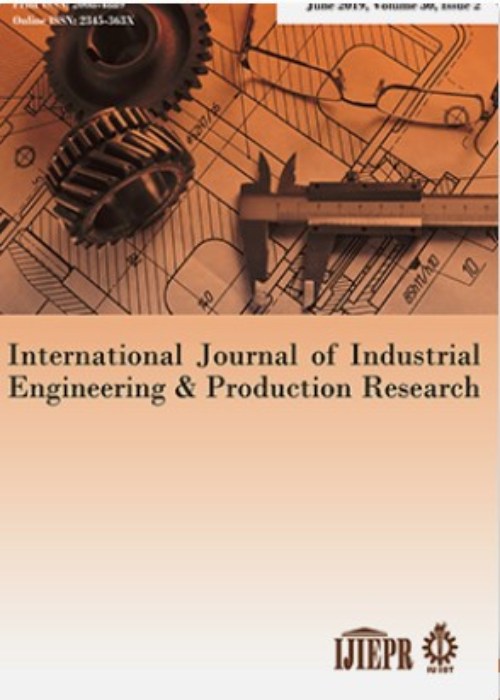فهرست مطالب

International Journal of Industrial Engineering and Productional Research
Volume:21 Issue: 2, sep 2010
- تاریخ انتشار: 1389/08/01
- تعداد عناوین: 8
-
-
Preparation of Papers for IUST International Journal of Industrial Engineering & Production ResearchPage 1The abstract is a brief (150-200 words) synopsis of your paper. Its use is to provide a quick outline of your presentation, giving the reader an overview of the research. This is an important aspect of your paper, as it is this description that may attract the reader to continue and finish your full report. In particular, the main contributions of the paper should be explicitly mentioned in the abstract. No citations or cross-references should be used there. Keywords should be so chosen that they best describe the contents of the paper.
-
Page 53In highly competitive industrial market, the concept of failure analysis is an unavoidable fact in complex industrial systems. Reliability of such systems not only depends on the reliability of each element of these systems, but also depends on occurrence of sequence of failures. In this paper, a novel approach to sequential failure analysis is proposed which is based upon fuzzy logic and the concept of Petri nets which is utilized to track all the risky behaviors of the system and to determine the potential failure sequences and then prioritizing them in order to perform corrective actions. The process of prioritizing failure sequences in this paper is done by a novel similarity measure between generalized fuzzy numbers. The proposed methodology is demonstrated with an example of two automated machine tools and two input/output buffer stocks.
-
Page 61This paper deals with the cellular manufacturing system (CMS) that is based on group technology concepts. CMS is defined as identifying the similar parts that are processed on the same machines and then grouping them as a cell. The most proposed models for solving CMS are focused on cell formation problem while machine layout is considered in few papers. This paper addresses a mathematical model for the joint problem of the cell formation problem and the machine layout. The objective is to minimize the total cost of inter-cell and intra-cell (forward and backward) movements and the investment cost of machines. This model has also considered the minimum utilization level of each cell to achieve the higher performance of cell utilization. Two examples from the literature are solved by the LINGO Software to validate and verify the proposed model.
-
Page 71The clustering problem under the criterion of minimum sum of squares is a non-convex and non-linear program, which possesses many locally optimal values, resulting that its solution often falls into these trap and therefore cannot converge to global optima solution. In this paper, an efficient hybrid optimization algorithm is developed for solving this problem, called Tabu-KM. It gathers the optimization property of tabu search and the local search capability of k-means algorithm together. The contribution of proposed algorithm is to produce tabu space for escaping from the trap of local optima and finding better solutions effectively. The Tabu-KM algorithm is tested on several simulated and standard datasets and its performance is compared with k-means, simulated annealing, tabu search, genetic algorithm, and ant colony optimization algorithms. The experimental results on simulated and standard test problems denote the robustness and efficiency of the algorithm and confirm that the proposed method is a suitable choice for solving data clustering problems.
-
Page 81A data envelopment analysis (DEA) method can be regarded as a useful management tool to evaluate decision making units (DMUs) using multiple inputs and outputs. In some cases, we face with imprecise inputs and outputs, such as fuzzy or interval data, so the efficiency of DMUs will not be exact. Most researchers have been interested in getting efficiency and ranking DMUs recently. Models of the traditional DEA cannot provide a completely ranking of efficient units; however, it can just distinguish between efficient and inefficient units. In this paper, the efficiency scores of DMUs are computed by a fuzzy CCR model and the fuzzy entropy of DMUs. Then these units are ranked and compared with two foregoing procedures. To do this, the fuzzy entropy based on common set of weights (CSW) is used. Furthermore, the fuzzy efficiency of DMUs considering the optimistic level is computed. Finally, a numerical example taken from a real-case study is considered and the related concept is analyzed.
-
Page 89This paper deals with minimization of tardiness in single machine scheduling problem when each job has two different due-dates i.e. ordinary due-date and drop dead date. The drop dead date is the date in which jobs’ weights rise sharply or the customer cancels the order. A linear programming formulation is developed for the problem and since the problem is known to be NP-hard, three heuristic algorithms are designed for the problem based on Tabu search mechanism. Extensive numerical experiments were conducted to observe and compare the behavior of the algorithms in solving the problem..
-
Page 97In this paper, we consider a flow shop scheduling problem with bypass consideration for minimizing the sum of earliness and tardiness costs. We propose a new mathematical modeling to formulate this problem. There are several constraints which are involved in our modeling such as the due date of jobs, the job ready times, the earliness and the tardiness cost of jobs, and so on. We apply adapted genetic algorithm based on bypass consideration to solve the problem. The basic parameters of this meta-heuristic are briefly discussed in this paper. Also a computational experiment is conducted to evaluate the performance of the implemented methods. The implemented algorithm can be used to solve large scale flow shop scheduling problem with bypass effectively.
-
Page 105This expository article shows how the maximum likelihood estimation method and the Newton-Raphson algorithm can be used to estimate the parameters of the power-law Poisson process model used to analyze data from repairable systems.


